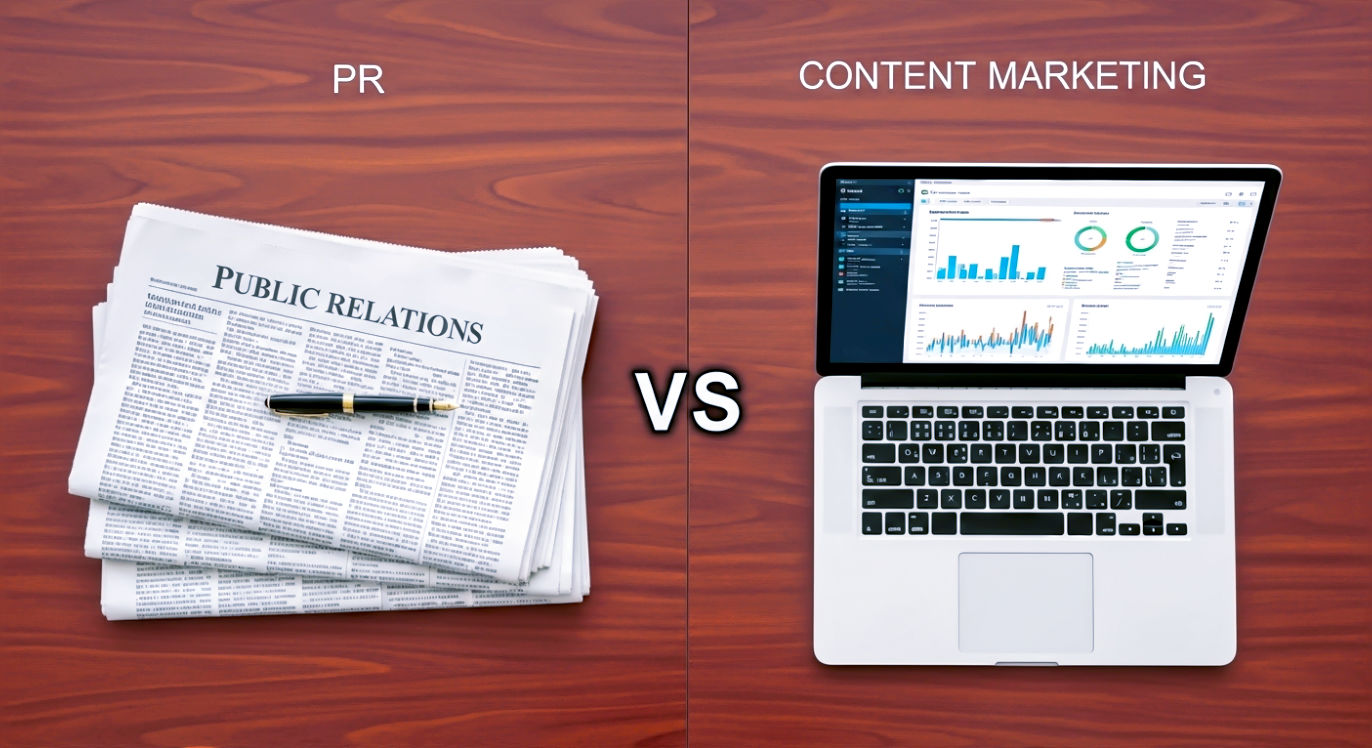This post may contain affiliate links. If you make a purchase through these links, we may earn a commission at no additional cost to you.
You’ve got a great product. Your team is brilliant. But in a noisy world, that’s not enough. To stand out, you need more than just a good reputation—you need brand authority. You need to be the name people trust, the one they recommend, and the first one that comes to mind when they have a problem you can solve.
So, how do you build it?
For decades, the answer was simple: Public Relations (PR). Hire a firm, get your name in the papers, and let the credibility of established media outlets rub off on you. But today, there’s another powerhouse on the scene: Content Marketing. The strategy of becoming your own media outlet, building a loyal audience by consistently providing value.
This often leads business leaders to a critical fork in the road. Where should you put your time and money? Is it the quick-hit credibility of a feature in a top-tier publication? Or the slow, compounding trust built through your own blog, podcast, or YouTube channel?
-
Learn the 7 universal story points that all humans respond to.
-
Simplify your brand message so customers finally understand what you offer.
-
Use a proven system trusted by over 500,000 business leaders.
-
Dramatically improve how you connect with customers to stop losing sales.
- Create effective messaging for websites, brochures, and social media.
Most articles will pit these two against each other in a deathmatch. They’ll give you a list of pros and cons and tell you to pick a side.
This isn’t one of those articles.
We’re going to take a different angle. While we will break down what each discipline does and compare them head-to-head, our real goal is to show you that “PR vs. Content Marketing” is the wrong way to think about it. The real question isn’t which one is better, but how they work together to create something far more powerful than either could alone.
Let’s start by defining the prize we’re all fighting for.
What is Brand Authority, and Why Should You Care?
Before we compare strategies, we need to agree on the goal. Brand authority isn’t just about brand awareness. Awareness means people have heard of you. Authority means they trust you.
It’s the difference between someone knowing your company sells software and someone believing your company sets the standard for that software.
Authority is a powerful business asset that:
- Shortens the sales cycle. When people already trust you, you don’t have to spend as much time convincing them. They come to you pre-sold on your expertise.
- Allows you to command premium pricing. Authoritative brands aren’t seen as commodities. They offer unique value that customers are willing to pay more for. Think Apple vs. a generic Android phone.
- Attracts top talent. The best people want to work for the most respected companies in their field.
- Builds a protective moat around your business. When the market gets tough or a competitor emerges, an authoritative brand has a deep well of customer loyalty and trust to draw from.
In short, brand authority is the ultimate competitive advantage. It’s what turns a business into a legacy. Now, let’s look at the two primary ways to build it.
The Classic Champion: Understanding Public Relations (PR)
Public relations is one of the most misunderstood functions in business. Many people think it’s just about writing press releases or “spinning” bad news. But that’s a tiny fraction of what it really is.

What PR Really Is (Beyond Press Releases)
At its core, public relations is the art of managing your reputation through third-party credibility.
The key phrase here is third-party credibility. A PR professional’s job is to get other credible people and organizations—journalists, influencers, industry experts, event organizers—to talk about you positively. It’s powerful because when someone else says you’re great, it carries far more weight than when you say it yourself. It’s the difference between an ad and a glowing review.
The PR Toolkit: From Media Pitches to Crisis Management
PR professionals use a variety of tools to build this third-party validation. Their work isn’t random; it’s a strategic effort to shape public perception.
- Media Relations: This is the bread and butter of PR. It involves building relationships with journalists, editors, and producers. The goal is to pitch them compelling stories about your company, products, or people, hopefully resulting in earned media—coverage you didn’t pay for.
- Press Releases: While often overused, a press release is still a valuable tool for major announcements like a product launch, a funding round, or a key executive hire. It’s a formal way to get your news into the hands of many journalists at once.
- Thought Leadership: This involves positioning your company’s leaders as go-to experts in your industry. This could mean securing them speaking spots at conferences, getting them featured on podcasts, or placing bylined articles they’ve written in trade publications.
- Crisis Communications: When things go wrong (and they sometimes do), a PR team steps in to manage the fallout. They craft the official response, handle media inquiries, and work to protect the company’s reputation from long-term damage.
- Influencer & Partner Relations: In the modern era, this has become a huge part of PR. It means identifying key influencers and partners in your space and building authentic relationships that lead to positive mentions and collaborations.
How PR Builds Authority: The Power of the Endorsement
PR builds authority through a psychological principle called transferred credibility.
When your company is featured in a publication like Forbes, The Wall Street Journal, or even a respected niche industry blog, your brand absorbs some of that publication’s authority. The reader thinks, “If this trusted source is talking about them, they must be important.”
This is an incredibly fast way to build perceived authority. A single well-placed article can instantly put you on the map and open doors that were previously closed.
The Modern Challenger: Understanding Content Marketing
If PR is about getting other people to talk about you, content marketing is about becoming so interesting that people want to talk to you directly. It flips the script entirely.
Learn how to create information and stories that customers actually want to engage with.
Get a step-by-step process to develop content that informs, entertains, and compels action.
Position your business as a trusted expert in its industry.
Capture the hearts and minds of customers to drive sales “through the roof.”
What Content Marketing Really Is (Beyond Blogging)
At its heart, content marketing is the process of creating and distributing valuable, relevant, and consistent content to attract and retain a clearly defined audience—and, ultimately, to drive profitable customer action.
The key word here is valuable. Content marketing isn’t about creating ads. It’s about providing genuine utility to your audience. You answer their questions, solve their problems, and entertain them. In doing so, you build a relationship with them over time. You stop interrupting what they’re interested in and you become what they’re interested in.
The Content Marketing Arsenal: From SEO to Social Media
Like PR, content marketing isn’t a single activity but a strategic system. It’s about creating valuable assets and then making sure the right people see them.
- Blogging & SEO: This is the foundation of most content marketing strategies. By creating high-quality articles that are optimized for search engines (SEO), you can attract a steady stream of people who are actively looking for solutions you provide.
- Video & Podcasting: These formats allow you to build a deeper, more personal connection with your audience. They’re perfect for showcasing your company’s personality, demonstrating complex products, and sharing expert interviews.
- Ebooks, White Papers, & Research Reports: These long-form pieces of content are authority-building machines. By producing original research or a definitive guide on a topic, you position your company as a leading expert.
- Email Marketing: An email list is one of the most valuable assets a content marketer can build. It’s a direct line of communication to your most engaged audience members, allowing you to nurture relationships and share your best content.
- Social Media: Social platforms are where you distribute your content and engage in conversations with your community. Each platform has its own strengths, whether it’s the professional networking of LinkedIn or the visual storytelling of Instagram.
How Content Marketing Builds Authority: The Power of Expertise
Content marketing builds authority from the ground up by consistently demonstrating your expertise.
Instead of borrowing credibility from a third party, you are earning it directly with your audience, one helpful article, one insightful video, one data-packed report at a time. This process is slower than PR, but the foundation of trust it builds is incredibly solid.
Your audience thinks, “This company has answered my questions ten times in a row without asking for anything in return. They really know their stuff. When I’m ready to buy, I’m going to them.” You become the source of truth in your industry.

The Head-to-Head Matchup: PR vs. Content Marketing for Brand Authority
Now that we understand both disciplines, let’s put them side-by-side. If your only goal was to build brand authority, which one gives you the edge in different areas?
| Feature | Public Relations (PR) | Content Marketing |
|---|---|---|
| Primary Goal | Build reputation via third-party validation | Build relationships via direct value creation |
| Control | Low. You can’t control what a journalist writes. | High. You control the message, platform, and timing. |
| Speed | Can be very fast. One big hit can change everything. | Slow and steady. It’s a marathon, not a sprint. |
| Cost | Often retainer-based. Can be high with unclear ROI. | Investment-based. Costs can start low and scale up. |
| Credibility | Borrowed. You leverage the authority of others. | Earned. You build your own authority from scratch. |
| Sustainability | Spiky. Media mentions have a short shelf life. | Compounding. SEO content can grow in value over time. |
| Measurement | Traditionally difficult to measure direct ROI. | Highly measurable with tools like Google Analytics. |
Let’s dig a little deeper into these key differences.
Control Over the Narrative
- PR: When you pitch a story to a journalist, you’re handing over control. They can write the story from a different angle, include a competitor, or get a fact wrong. The final product is out of your hands.
- Content Marketing: You have 100% control. You decide the topic, the tone, the keywords, and when to publish. Your blog is your kingdom.
Winner for Authority: Content Marketing, because you can meticulously craft a narrative that showcases your expertise exactly as you intend.
Speed and Scalability
- PR: A single placement in a major outlet can generate massive authority overnight. However, this is hard to scale. You can’t just decide to get 10 major media hits next month; it depends on factors outside your control.
- Content Marketing: It’s a slow burn. It can take 6-12 months of consistent effort to see significant results. But once the engine is running, it’s highly scalable. You can increase your output and expand to new channels.
Winner for Authority: PR for short-term impact, Content Marketing for long-term, scalable growth.
Cost and ROI
- PR: Agency retainers can be expensive, often starting at $5,000-$10,000 per month. The return on investment (ROI) can be hard to pin down. How do you measure the dollar value of a mention in a magazine?
- Content Marketing: The cost is an investment in creating assets. You can start small by writing your own articles. As you grow, you might hire writers or video producers. The ROI is much clearer. You can track how many leads and sales a specific blog post generates.
Winner for Authority: Content Marketing, because the ROI is more transparent and the value compounds over time.
Credibility and Trust
- PR: The third-party endorsement from a trusted media outlet is incredibly powerful. For many people, a journalist’s word is more credible than a company’s blog.
- Content Marketing: You earn trust over time by being consistently helpful and reliable. It’s a deeper, more resilient form of trust built on a direct relationship.
Winner for Authority: A tie. PR provides a powerful shortcut to credibility, while content marketing builds a more durable foundation of trust.
Sustainability and Longevity
- PR: A news article is hot today and gone tomorrow. The traffic and buzz from a media hit are usually a temporary spike.
- Content Marketing: A well-optimized blog post can attract traffic from search engines for years. This is often called the “compounding” effect of content. Your old work continues to deliver value long after you publish it.
Winner for Authority: Content Marketing, by a long shot. It builds a lasting asset for your brand.
A Different Angle: Why “Versus” Is the Wrong Question
Looking at the comparison table, you might be tempted to declare a winner. But doing so would be a huge strategic mistake. You’d be missing the real opportunity.
PR and content marketing aren’t competitors. They are two halves of a powerful authority-building engine. When you integrate them, you don’t just add their strengths together; you multiply them.
This is the different angle we promised. Stop thinking “PR or Content.” Start thinking “PR and Content.”
Make idea generation effortless and produce fresh story ideas on demand.
Overcome writer’s block and stop asking, “what should I post?”
Meet the high-pressure demand for unique, consistent content.
Get an adaptable and evergreen guide you can use again and again.
The Flywheel Effect: How PR and Content Marketing Fuel Each Other
Imagine a flywheel. It’s hard to get it spinning, but once it’s moving, each push adds to its momentum, and it spins faster and with less effort. This is exactly what happens when you combine PR and content marketing.
- Content gives your PR team something to talk about.
- PR gets your best content in front of a much bigger audience.
This creates a self-reinforcing loop. Let’s break down how to make this happen.
Use Content to Power Your PR
A PR professional’s biggest challenge is answering the question, “Why should a journalist care?” A great piece of content is the perfect answer.
- Create Original Research: Conduct a survey in your industry and publish the results in a detailed report. This data is pure gold for journalists who are always looking for new stats to cite. Your PR team can pitch this report to hundreds of outlets, and every time someone cites your data, they link back to your site, building both authority and SEO.
- Develop Strong Opinions: Write a thought-provoking article that takes a controversial but well-argued stance on an industry trend. This makes your executives interesting to journalists and podcast hosts who want a guest with a clear point of view.
- Build Ultimate Guides: Create the most comprehensive, helpful guide on a core topic in your industry. This becomes a “linkable asset.” Your PR team can offer it as a resource to journalists writing about that topic.
Use PR to Amplify Your Content
Your content team’s biggest challenge is distribution. You can write the best article in the world, but if no one sees it, it doesn’t build authority.
- Promote Your Best Pieces: When you publish a major piece of content, like the research report we mentioned, your PR team should treat it like a product launch. They can write a press release about the key findings and pitch it to relevant media.
- Land Guest Posts: A key PR tactic is placing articles on other websites. Your content team can write these articles, which allows you to tap into another site’s audience and gain a valuable backlink for SEO.
- Turn Executives into Sources: Your PR team can use services like Help a Reporter Out (HARO) to find journalists looking for expert quotes. Your content (and the experts who create it) makes them the perfect source. Every quote they give builds their personal brand and the company’s authority.
The Integrated Strategy: A Practical Blueprint
- Sit Down Together: Get your PR and Content teams in the same room (or on the same video call).
- Set a Shared Goal: The goal isn’t “get 5 media hits” or “publish 4 blog posts.” The goal is “become the most trusted voice in our industry.”
- Build a Unified Calendar: Plan your big content pieces (your “rock” content) for the quarter. Then, plan the PR campaign that will support each piece before it even goes live.
- Create a Feedback Loop: Your PR team knows what topics journalists are covering. They can feed this information to the content team to inspire new ideas. The content team can then create the perfect piece of content to meet that need.

Case Study: Brands That Master the Integration
One of the best examples of this integrated approach is HubSpot.
- Content: Their blog is a legendary resource for marketers and salespeople. They produce ebooks, research reports (like the annual “State of Inbound” report), and free tools.
- PR: They take the data from their reports and get it featured in major business publications. Their executives are frequent guests on podcasts and at industry events, always referencing the helpful frameworks they’ve developed in their content.
HubSpot didn’t choose between PR and content. They used their world-class content to fuel a world-class PR machine, and in the process, they built unshakeable brand authority in the marketing software space.
Making the Right Choice for Your Business
Even in an integrated strategy, you might need to lean more heavily on one discipline at different stages of your business.
When to Lead with PR
- Product Launches: When you have a specific, time-sensitive announcement, the burst of attention from PR is invaluable.
- Entering a New Market: PR can quickly build the initial credibility you need to be taken seriously.
- Crisis Situations: This is PR’s domain. When your reputation is on the line, you need expert communications management.
- Major Funding Announcements: Announcing a significant investment is a classic PR play to generate buzz and validation.
When to Lead with Content Marketing
- Early-Stage Startups on a Budget: Content marketing can be started with sweat equity and builds a long-term asset from day one.
- Complex or Niche Industries: If you sell a product with a long sales cycle or a steep learning curve, content is the best way to educate your market and build trust.
- SEO is a Key Growth Channel: If you know your customers are searching for solutions on Google, a content- and SEO-focused strategy is non-negotiable.
Conclusion: Building a Legacy, Not Just a Headline
In the debate between PR services and content marketing, there is no single winner, because the premise of the fight is flawed.
PR offers a powerful jolt of third-party credibility, borrowing authority to put you on the map quickly. Content marketing builds a deep, lasting foundation of trust by earning it directly from your audience. One provides the spark; the other provides the slow-burning fuel.
A headline from a major newspaper will be forgotten in a week. But a library of genuinely helpful content that serves your industry builds a legacy. It becomes a resource that your customers, partners, and even the media rely on for years to come.
Don’t choose between them. Challenge your teams to work together. Use groundbreaking content to give your PR team stories worth telling. Use the reach of PR to ensure that your valuable content is seen by everyone who needs it.
That’s how you stop chasing fleeting buzz and start building true, enduring brand authority.
Further Reading
- Content Marketing Institute
- Public Relations Society of America (PRSA)
- The HubSpot Marketing Blog
- Moz’s Beginner’s Guide to SEO
- Search Engine Journal









